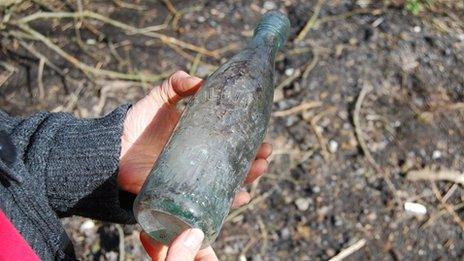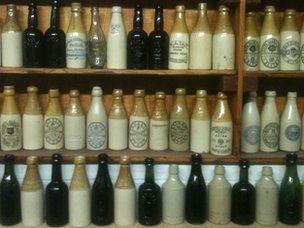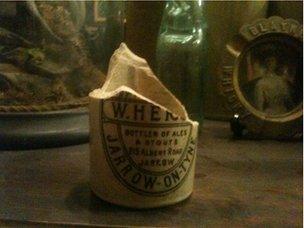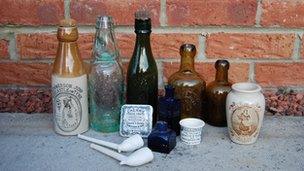Bottle digging in old dumps can yield collectable finds
- Published

Old bottles are common finds on Victorian and Edwardian rubbish dumps, although this late example is not collectable
Digging up bottles from old rubbish dumps may be an unusual pastime but some of the rarer finds can sell for hundreds of pounds.
Bottle digger Steven Armstrong describes his hobby scouring Victorian and Edwardian dumps as "archaeology for the man in the street" .
Some of his finds he keeps for his own collection, but he has sold most of the hundreds of bottles he has dug up over the years.
The Northumberland and Durham Bottle Collectors' Club has 80 members, while many others in the region pursue the pastime on a less formal basis.
Mr Armstrong, from Stanley in County Durham, said most of the collectable ones he sold went for between £5 and £50, but some have fetched much more.

Part of County Durham collector Phil Hall's impressive display
"I've had a couple through my hands that sold for £700, one that sold a couple of years ago for just less than £2,000," he said.
Ethical issues
Like with any collectable item, the value depends on rarity, condition and appearance.
Many go on sale at shows and auctions organised specially for bottle collectors, while others change hands between friends and acquaintances.
In his book Digging for Treasure, veteran bottle digger Ron Dale said specimens worth £5 to £8 when he first started out in the 1970s now sell for £800 to £1,000.
These are not just any old bottles however. The ones collectors are interested in are from about 100 to 130 years ago, when bottles were altogether more interesting than they are today.
Before World War I, most were essentially hand-made and had all sorts of charming idiosyncrasies as a result.
As well as hand-blown glass, many of the coveted Edwardian and Victorian specimens are stoneware.
Sadly, said Mr Armstrong, the demand for these valuable objects has led to unauthorised digs in which allotment sites, golf courses and other pieces of land have been turned over and ruined.

No whole version of this rare "Heron" bottle, owned by collector Phil Hall, is known to have been found
"When people have discovered that there are bottles underneath the ground, they have no regard for what is above the ground," he said.
The Northumberland and Durham Bottle Collectors' Club imposes strict rules on its members to curb this kind of behaviour.
Its code of conduct specifies that members must obtain permission, preferably in writing, from landowners before digging their land.
Identifying where to dig in the first place, however, is no easy thing.
The main sources of bottles are Victorian and Edwardian rubbish dumps, containing mainly coal ash from household fires.
It is that ash that bottle diggers look for when they first stick their spades in the ground.
"There is a basic detective work in looking for a likely spot and looking for a place you think you might have tipped rubbish," Mr Armstrong said.
He also said certain plants - namely nettles, elderberries and rosebay willowherbs - were potential signs of an old tip, because they enjoy the acidic soil and good drainage created by the ash.
Difficult to find
But these ash dumps were only a relatively late phenomenon. Before about 1880, there was no organised waste disposal outside of London.
Even in London, until the 1870s, the only refuse collection was by contractors who paid councils for the privilege of gathering waste so they could resell it, such was its value for reuse.
This incredibly efficient recycling stopped when industrial techniques developed to a point where reusing old materials became uneconomical.
So from about 1880 onwards, councils started paying to have rubbish dumped in landfill.
It was in that short window, lasting until about the time of World War I when bottle manufacturing became much more industrialised, that most of the now coveted vessels were preserved.

Cream pots, toothpaste pot lids and clay pipes are among the objects found alongside bottles in old tips
To put that into perspective, archaeological sites containing Roman treasure can have a range of artefacts spanning centuries.
Mr Armstrong said, due to their finite nature, it is now much more difficult than it once was to find fruitful digging sites.
"It's not like in the past where people would easily trade and swap and divulge sites," he said.
"Now, if you've got somewhere that's half-decent for to go and dig, you'll keep it to yourself as much as you can."